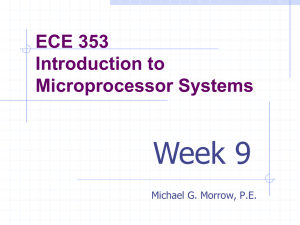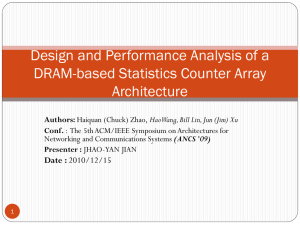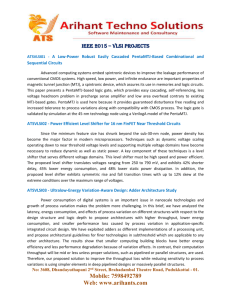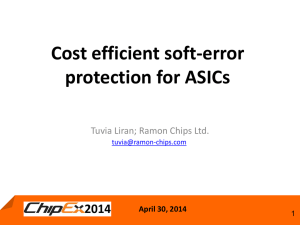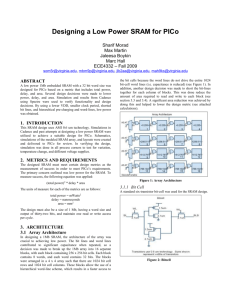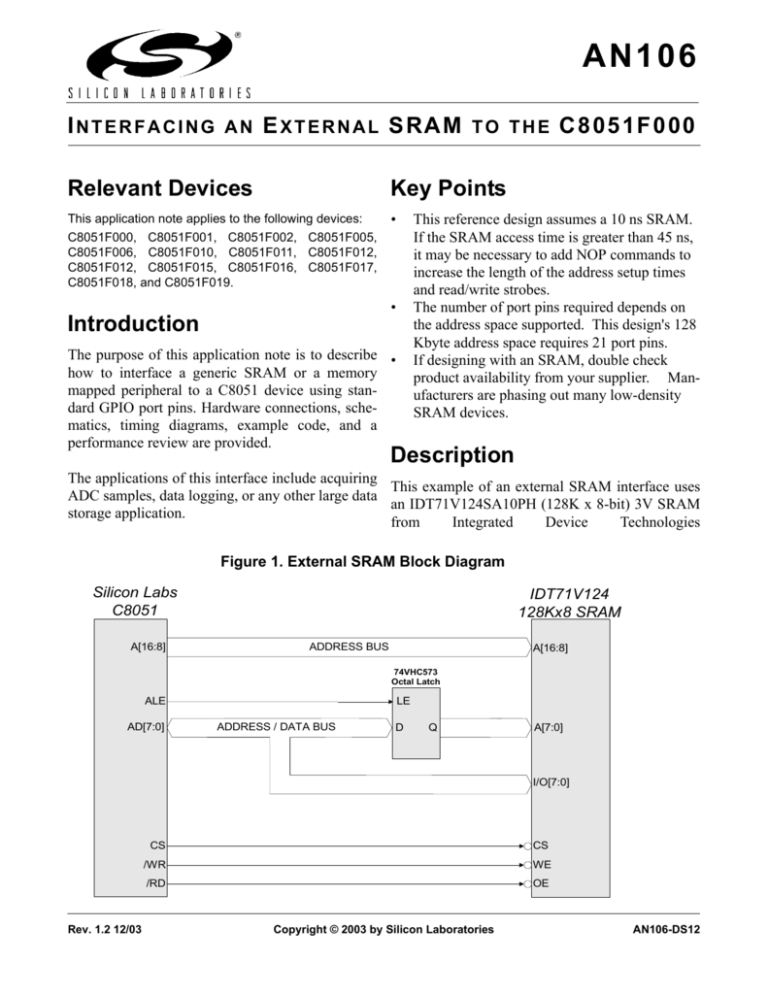
AN106
I N T E R F A C I N G A N E X T E R N A L SRAM T O T H E C8051F000
Relevant Devices
Key Points
This application note applies to the following devices:
•
This reference design assumes a 10 ns SRAM.
If the SRAM access time is greater than 45 ns,
it may be necessary to add NOP commands to
increase the length of the address setup times
and read/write strobes.
The number of port pins required depends on
the address space supported. This design's 128
Kbyte address space requires 21 port pins.
If designing with an SRAM, double check
product availability from your supplier. Manufacturers are phasing out many low-density
SRAM devices.
C8051F000, C8051F001, C8051F002, C8051F005,
C8051F006, C8051F010, C8051F011, C8051F012,
C8051F012, C8051F015, C8051F016, C8051F017,
C8051F018, and C8051F019.
•
Introduction
The purpose of this application note is to describe •
how to interface a generic SRAM or a memory
mapped peripheral to a C8051 device using standard GPIO port pins. Hardware connections, schematics, timing diagrams, example code, and a
performance review are provided.
Description
The applications of this interface include acquiring
This example of an external SRAM interface uses
ADC samples, data logging, or any other large data
an IDT71V124SA10PH (128K x 8-bit) 3V SRAM
storage application.
from
Integrated
Device
Technologies
Figure 1. External SRAM Block Diagram
Silicon Labs
C8051
A[16:8]
IDT71V124
128Kx8 SRAM
ADDRESS BUS
A[16:8]
74VHC573
Octal Latch
ALE
AD[7:0]
LE
ADDRESS / DATA BUS
D
Q
A[7:0]
I/O[7:0]
Rev. 1.2 12/03
CS
CS
/WR
WE
/RD
OE
Copyright © 2003 by Silicon Laboratories
AN106-DS12
AN106
(www.idt.com), although any generic SRAM will
work in a similar fashion. The interface uses a
multiplexed address and data bus to reduce the
number of port pins required. The lower address
bits are held in a latch while data is transferred.
Figure 4 on page 5 shows the tested configuration
of this implementation.
Bi-Directional Port Operation
Figure 4. The connections, designations, and signal names are as follows:
The multiplexed address/data bus 'AD[7..0]', designated 'DATA1' in the example code support the
lower 8 bits of the address and the 8 bits of data.
This configuration allows the lower address lines to
be held by the '573 latch while the SRAM and
C8051 transfer data, such that 8 additional ports for
data transfer are not necessary.
'Data1' is used as a data input bus, output bus, and
partial address bus. Multiplexing the bus requires 'A[15..8]', designated 'ADDR' in the example code,
dynamic port configuration changes to make the supply the upper 8 bits of the address.
port an input or an output as needed.
'A16', also designated 'A16' in the example code,
To configure a port pin as an input, its associated acts as a bank select between the two 64 Kbyte
Port Configuration Register bit (PRTnCF.x) must banks. A '0' is bank one and '1' is bank two.
be set to a '0', which makes it's output mode 'opendrain', and it's register latch bit (Pn.x) must be set to 'RD', 'WR', 'ALE', and 'CS' are control signals and
a '1', which makes it's output state 'hi-z'. For exam- have the same corresponding names in the example
ple, the following code configures all the pins of code. 'RD' is the read strobe (operates active low).
Port 0 as inputs:
'WR' is the write strobe (operates active low).
'ALE' is the address latch signal that holds the
mov PRT0CF,#00h ;Open-drain
lower 8 address bits during data transfer. 'CS' is the
;output mode
SRAM chip select (operates active low).
mov 0, #ffh
;high-impedance
Software Operation
This code configures all of Port 0's pins as pushThe three software routines used to access the
pull outputs:
SRAM are 'SRAM_Init', 'SRAM_Read', and
'SRAM_Write'.
mov PRT0CF,#ffh ;Push-Pull output
The ‘SRAM_Read’ routine (See “Software Example” on page 6) gives an example of changing the
port direction. During the first phase of the routine,
the 'DATA1' port is configured as an output to drive
the least-significant address byte onto the port
latch. In the second phase of the routine, the
'DATA1' port is configured as an input to read the
value from the external SRAM.
The 'SRAM_Init' routine initializes the SRAM
interface logic and port configurations. This routine is only called in the initialization sequence of
the device. This routine assumes that the crossbar
has already been enabled (XBR2.6 = '1'). For
example:
Signals and Connections
mov XBR2, #40h ;enable Crossbar
acall SRAM_Init ;initialize SRAM
The 'SRAM_Read' routine reads a byte from the
Figure 1 shows a block diagram of the hardware external SRAM. To use this routine, load DPTR
connections between the C8051 MCU, SRAM, and with the sixteen-bit address to be read, call
address latch. The entire schematic is shown in 'SRAM_Read', and the routine returns in ACC the
2
Rev. 1.2
AN106
data at the address pointed to by DPTR. For exam- is valid. The corresponding code lines for this
ple:
sequence are:
mov DPH, #00h
;load addr high
mov DPL, #00h
;load addr low
acall SRAM_Read ;perform read
;data is returned
;in ACC
clr RD
;activate READ strobe
;NOP
;add NOPs to extend tRDSU
mov a, DATA ; read the data
setb RD
; de-assert READ strobe
It may be necessary to add NOP instructions after
The 'SRAM_Write' routine writes the byte in ACC the 'clr RD' instruction as shown above to extend
to the external SRAM at the address pointed to by 'tRDSU' in order to meet the setup time of the
DPTR. To use this routine, load ACC with the data SRAM.
to be written, load DPTR with the 16-bit address,
and call 'SRAM_Write'. For example:
Write Timing Notes
As shown in Table 1, 'tWR' refers to the '/WR' pulse
width. The following code sequence executes the
pulse.
mov DPH, #00h ;load addr high
mov DPL, #00h ;load addr low
mova, #55h
;load value to write
acall SRAM_Read ;perform write
The main program in the example code section outlines how to write to and read from every byte in
the external 128 Kbyte SRAM. The program
writes a byte to external RAM, reads that address
location, and verifies the value read is the same as
the written value. The program then proceeds to
the next address space and continues until the
entire 64K bank has been written to. Once the
lower bank has been written the program switches
to the upper bank by setting the 'A16' bit (see the
"Constants and Declarations" section in the software example). The routine then performs the same
read, write, and verify operation for every byte in
the upper bank.
clr WR ; activate WRITE strobe
;NOP
; add NOPs to extend tWRSU
setb WR ; de-assert WRITE strobe
It may be necessary to add NOP instructions after
the 'clr WR' instruction as shown above to extend
'tWR' in order to meet the setup time of the SRAM.
Performance
This multiplexed parallel interface implementation
achieves high throughput performance with moderate Port I/O consumption. A byte-read operation or
byte-write operation, each takes 34 SYSCLK
cycles from procedure entry point to return-fromcall inclusive, which takes 1.7 µs with a 20 MHz
SYSCLK. This achieves a maximum transfer rate
Timing Description
of 588K bytes per second. A 64K bank can be
Figure 2 and Figure 3 show timing waveforms for filled in 137 µs.
reads and writes respectively, as implemented by
the example code. Table 1 shows the timing values
for these figures.
Read Timing Notes
'tRDSU' (Table 1) refers to the time period from
when the read strobe is activated to when the data
Rev. 1.2
3
AN106
Figure 2. Read Cycle Timing Waveform
CS
A[15..8]
A15...8
AD[7..0]
A7...0
ALE
D7...0
tALE
/RD
tRDS
Figure 3. Write Cycle Timing Waveform
CS
A[15..8]
AD[7..0]
ALE
A15...8
A7...0
D7...0
tWDSU
tALE
tWR
/WR
tWASU
Table 1. Read and Write Cycle Timing
Symbol
Parameter
Cycles
Time
SYSCLK = 20MHz
READ CYCLE
tALE
Latch Pulse Width
2
100ns
tRDSU
Data Setup Time
2
100ns
tALE
Latch Pulse Width
2
100ns
tWASU
Address Setup Time
3
300ns
tWDSU
Data Setup Time
4
200ns
tWR
Write Pulse Width
2
100ns
WRITE CYCLE
4
Rev. 1.2
AN106
Figure 4. Tested Configuration of C8051F000, 128k x 8 SRAM, and Address Latch
Rev. 1.2
5
AN106
Software Example
;----------------------------------------------------------------------------; Copyright (C) 2000 CYGNAL INTEGRATED PRODUCTS, INC.
; All rights reserved.
;
;
; FILE NAME
: Sram.ASM
; TARGET MCU : C8051F000
; DESCRIPTION : External Sram read/write verification routine for
;
IDT 71V124SA.
;
;
;----------------------------------------------------------------------------; EQUATES
;----------------------------------------------------------------------------$NOLIST
$MOD8F000
$LIST
;--------------------------------------; Constants and Declarations
;--------------------------------------DATA1
DATACF
ADDR
ADDRCF
A16
RD
WR
ALE
CS
EQU
EQU
EQU
EQU
EQU
EQU
EQU
EQU
EQU
P3
PRT3CF
P2
PRT2CF
P1.5
P1.4
P1.3
P1.2
P1.1
;
;
;
;
;
;
;
;
;
port for DATA pins(AD7..0)
port configuration register for DATA
port for ADDR pins(A15..8)
port configuration register for ADDR
upper address bit(address bank select)
READ strobe (activelow)
WRITE strobe (activelow)
address latch signal(active low)
SRAM chip select(active low)
;----------------------------------------------------------------------------; VARIABLES
;----------------------------------------------------------------------------;----------------------------------------------------------------------------; RESET and INTERRUPT VECTORS
;----------------------------------------------------------------------------; Reset Vector
org
ljmp
00h
Main
;----------------------------------------------------------------------------; MAIN PROGRAM CODE
;----------------------------------------------------------------------------org
0B3h
Main:
; Disable the WDT. (IRQs not enabled at this point.)
; if interrupts were enabled, we would need to explicitly disable
; them so that the following two instructions were guaranteed to
6
Rev. 1.2
AN106
; to execute within 4 clock cycles of each other.
mov
WDTCN, #0DEh
mov
WDTCN, #0ADh
; Set up the XBar.
mov
XBR2, #40h
lcall
SRAM_Init
; Weak pull-ups, XBAR enabled.
; Initialize SRAM
mov
mov
mov
mov
; initialize 16bit address
;
; load write value
R0, #0ffh
DPH, #00h
DPL, #00h
a, R0
; Loop will write a value to ram, read it, then verify the value
loop:
lcall
clr
lcall
cjne
inc
mov
orl
jz
SRAM_Write
a
SRAM_Read
a, 00h, error
dptr
a, DPH
a, DPL
b1done
mov
jmp
a, R0
loop
orl
mov
mov
mov
mov
P1, #00111010b
R0, #0ffh
DPH, #00h
DPL, #00h
a, R0
; write to sram
; clear load value
; read same address
;
;
;
;
;
;
;
next address
check dptr for finished
we are finished with the first 64k bank
if dptr rolls over
reload write value
write; read; and verify again
b1done:
; change to bank 2
; initialize 16bit address
;
; load write value
; Loop will write a value to ram, read it, then verify the value
loop1:
b2done:
error:
lcall
clr
lcall
cjne
inc
mov
orl
jz
SRAM_Write
a
SRAM_Read
a, 00h, error
dptr
a, DPH
a, DPL
b2done
; write to sram
; clear load value
; read same address
mov
jmp
a, R0
loop1
;
;
;
;
;
;
;
jmp
jmp
$
$
;
; a verification error has occured
next address
check dptr for finished
we are finished with the first 64k bank
if dptr rolls over
reload write value
write; read; and verify again
;--------------------------------------; SRAM_Init
;--------------------------------------; This routine initializes the SRAM interface logic.
Rev. 1.2
Must be called once
7
AN106
; before any SRAM_Read or SRAM_Write operations, typically as part ofthe
; reset sequence. This routine assumes that the crossbar has already been
; enabled (XBR2.6 = ‘1’).
;
SRAM_Init:
mov
DATACF, #00h
; Enable Port3 (DATA) as aninput bus
mov
DATA1, #0ffh
mov
ADDRCF, #0ffh
; Enable Port2 (ADDR) as anoutput
mov
ADDR, #0ffh
; driven high ($ff)
orl
PRT1CF, #00111110b
; enable P1.7..3 as outputs
anl
P1, #11011011b
; A16 = ‘0’; ALE = ‘0’
bank 1
orl
P1, #00011010b
; RD, WR, CS = ‘1’
ret
;--------------------------------------; SRAM_Read
;--------------------------------------; This routine reads from the external SRAM. Specifically, it returns
; in ACC the data at the address pointed to by DPTR. Bank select
; (manipulation of A16) is not handled here.
;
SRAM_Read:
clr
CS
; select external SRAM
mov
ADDR, DPH
; force external address A15..A8
mov
DATACF, #0ffh
; enable AD7..0 as outputs
mov
DATA1, DPL
; force external address A7..A0
setb ALE
; latch the address
clr
ALE
mov
DATACF, #00h
; enable AD7..0 as inputs
mov
DATA1, #0ffh
clr
RD
; activate READ strobe
mov
a, DATA1
; read the data (note: setuptime for OE-based
;
reads is 45ns forthis SRAM. At SYSCLK
;
= 20MHz, this move takes 2 clock cycles, or
;
50ns * 2 = 100ns.
setb RD
; de-assert READ strobe
setb CS
; de-select SRAM
ret
;Totals for a read are:
;30 bytes, 34 cycles.
;--------------------------------------; SRAM_Write
;--------------------------------------; This routine writes a byte to the external SRAM. Specifically, it writes
; the byte in ACC to the address pointed to by DPTR. Bank select
; (manipulation of A16) is not handled here.
;
SRAM_Write:
clr
CS
; select external SRAM
mov
ADDR, DPH
; force external address A15..A8
mov
DATACF, #0ffh
; enable AD7..0 as outputs
mov
DATA1, DPL
; force external address A7..A0
setb ALE
; latch the address
clr
ALE
8
Rev. 1.2
AN106
mov
clr
setb
DATA1, a
WR
WR
;
;
;
;
;
;
;
present the data to the DATA bus
activate WRITE strobe
de-assert WRITE strobe
note: this results in a write pulse width
of 100ns with a 20MHz sysclk. The minimum
width for this SRAM is 60ns.
enable AD7..0 as inputs
mov
DATACF, #00h
mov
DATA1, #0ffh
setb CS
; de-select SRAM
ret
;----------------------------------------------------------------------------; End of file.
END
Rev. 1.2
9
AN106
Contact Information
Silicon Laboratories Inc.
4635 Boston Lane
Austin, TX 78735
Tel: 1+(512) 416-8500
Fax: 1+(512) 416-9669
Toll Free: 1+(877) 444-3032
Email: productinfo@silabs.com
Internet: www.silabs.com
The information in this document is believed to be accurate in all respects at the time of publication but is subject to change without notice.
Silicon Laboratories assumes no responsibility for errors and omissions, and disclaims responsibility for any consequences resulting from
the use of information included herein. Additionally, Silicon Laboratories assumes no responsibility for the functioning of undescribed features
or parameters. Silicon Laboratories reserves the right to make changes without further notice. Silicon Laboratories makes no warranty, representation or guarantee regarding the suitability of its products for any particular purpose, nor does Silicon Laboratories assume any liability
arising out of the application or use of any product or circuit, and specifically disclaims any and all liability, including without limitation consequential or incidental damages. Silicon Laboratories products are not designed, intended, or authorized for use in applications intended to
support or sustain life, or for any other application in which the failure of the Silicon Laboratories product could create a situation where personal injury or death may occur. Should Buyer purchase or use Silicon Laboratories products for any such unintended or unauthorized application, Buyer shall indemnify and hold Silicon Laboratories harmless against all claims and damages.
Silicon Laboratories and Silicon Labs are trademarks of Silicon Laboratories Inc.
Other products or brandnames mentioned herein are trademarks or registered trademarks of their respective holders.
10
Rev. 1.2


